

|
| DEUTSCHLAND | GERMANY |
| Bundesland: Schleswig-Holstein | |
| Hansestadt: Lübeck |
Lübeck is situated at the confluence of the rivers Trave and Wakenitz. The first mention in of Liubice dates from the 2nd half of the 11th century and referred to a slavic settlement at the Trave about 6 km down the river. In 1127/1138 this settlement was destroyed, and the name was transferred to a German settlement which had replaced an older slavic village called Baku. In 1158 Lübeck came into possession of Heinrich the Lion, Duke of Saxony and Bavaria, who granted special rights to the town in 1161/63. The bishopric of Oldenburg (Oldenburg in Holstein) was transferred to Lübeck in 1160. After the fall of Heinrich the Lion, it came into possession of Emperor Friedrich I (Barbarossa) who granted further rights in 1188. Between 1201/01 and 1225 Lübeck was part of Denmark. In 1226 Lübeck obtained the status of an Imperial Town ('specialis civitas at locus imperii'). Due to its favourable location for the trade between Novgorod and Brugge it became one of the most important trading places in Europe. During the 14th century Lübeck became the leading city of the Hanse federation of European trading towns that was first mentioned in 1282. From the 16th century on Lübeck lost this leading position. In 1815 it became a member of the German Federation (Deutscher Bund; see map) as a 'Free and Hanseatic Town'. Lübeck joined the North German Federation in 1866 and the German Customs Union in 1868, and became part of the German Empire (Deutsches Reich; see map) in 1871. In 1937, Lübeck lost its independence and became part of the province Schleswig-Holstein of Prussia. The old town of Lübeck was listed as a UNESCO World Heritage site in 1987 (see also list of other UNESCO heritage sites).
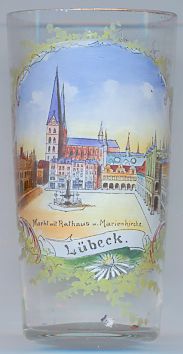
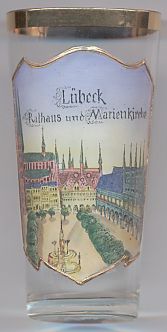 The church
The church  Sankt Marien [left, no. 2393: left; right, no. 2244: left; below left, no. 2244: top picture, background left]
was built between 1230 and 1350. For many years, it has been a symbol of the power and prosperity of the old Hanseatic city, and as Germany's third largest church it
remains the tallest building of the old part of Lübeck. Along with Lübeck, the church has been listed by UNESCO as of cultural significance.
It is a model for the brick Gothic style of north Germany and this is reflected in approximately 70 churches in the Baltic Area.
At 38.5 m (125 ft) it the church has the highest brick vault in the world. Taking the weathervanes into account, the towers are, 124.95 m (406 ft)
and 124.75 m (405.5 ft) high. On the night of Palm Sunday from the 28th to the 29th of March 1942, the Marienkirche was almost completely burnt out during an
Allied bombing raid along with about a fifth of Lübeck city centre. The bells of the church which fell down during the ensuing blaze still lay on the ground in the
position they fell to this day, where they remain as a warning memorial. They can be seen in the Gedenkkapelle in the south tower. The Marienkirche was protected by an
emergency temporary roof for the rest of the war. Reconstruction began in 1947 and 12 years later the majority of this was complete.
The guilded ridge turret which stands 30 metres higher than the nave roof was recreated in 1980 from old designs and photographs.
[Text adapted from http://en.wikipedia.org/wiki/St._Mary's_Church,_Lübeck]
Sankt Marien [left, no. 2393: left; right, no. 2244: left; below left, no. 2244: top picture, background left]
was built between 1230 and 1350. For many years, it has been a symbol of the power and prosperity of the old Hanseatic city, and as Germany's third largest church it
remains the tallest building of the old part of Lübeck. Along with Lübeck, the church has been listed by UNESCO as of cultural significance.
It is a model for the brick Gothic style of north Germany and this is reflected in approximately 70 churches in the Baltic Area.
At 38.5 m (125 ft) it the church has the highest brick vault in the world. Taking the weathervanes into account, the towers are, 124.95 m (406 ft)
and 124.75 m (405.5 ft) high. On the night of Palm Sunday from the 28th to the 29th of March 1942, the Marienkirche was almost completely burnt out during an
Allied bombing raid along with about a fifth of Lübeck city centre. The bells of the church which fell down during the ensuing blaze still lay on the ground in the
position they fell to this day, where they remain as a warning memorial. They can be seen in the Gedenkkapelle in the south tower. The Marienkirche was protected by an
emergency temporary roof for the rest of the war. Reconstruction began in 1947 and 12 years later the majority of this was complete.
The guilded ridge turret which stands 30 metres higher than the nave roof was recreated in 1980 from old designs and photographs.
[Text adapted from http://en.wikipedia.org/wiki/St._Mary's_Church,_Lübeck]
The  town hall [left, no. 2244: right] of Lübeck is one of the most important examples of
medieval architecture in northern Germany.
Its construction began shortly after Lübeck had obtained its city rights in 1226. From this early building in late Romanesque style parts are still preserved
in the southern wall. The construction was completed in 1308. In 1435 the late Gothic 'Neues Gemach' and the monumental fa&ccade;ade were added.
Some 150 years later the Renaissance alcove on the market side followed. The Dutch Renaissance outside staircase at the Breite Straße was constructed in 1594.
Even today, the historic building is the seat of the mayor of Lübeck and the seat of the city council (the 'Bürgerschaft').
town hall [left, no. 2244: right] of Lübeck is one of the most important examples of
medieval architecture in northern Germany.
Its construction began shortly after Lübeck had obtained its city rights in 1226. From this early building in late Romanesque style parts are still preserved
in the southern wall. The construction was completed in 1308. In 1435 the late Gothic 'Neues Gemach' and the monumental fa&ccade;ade were added.
Some 150 years later the Renaissance alcove on the market side followed. The Dutch Renaissance outside staircase at the Breite Straße was constructed in 1594.
Even today, the historic building is the seat of the mayor of Lübeck and the seat of the city council (the 'Bürgerschaft').
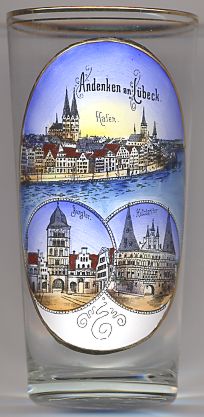
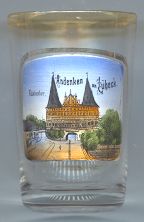 The
The  Holstentor [left, no. 2244: bottom right picture; and right, no. 1052] is the landmark of Lübeck and belongs to the best-known architectural monuments in Germany.
The representative Late Gothic gate house was built in 1464–1478 and during the 15th/16th century was part of the town's fortifications. Already during the period of its construction,
its enormous weight caused the building to sink into the ground. Today, the bottommost row of loopholes lies 0.5 m underground. During the 16th century
a second gate in splendid Late Renaissance style was built some 15 m outside the old gate. This second gate was pulled down in 1853 to make room for
Lübeck's first railway station that existed until 1908. Following a referendum in 1863, the ruins of the Holstentor were renovated until 1871. A further renovation
was carried out in 1931/33 to secure the structure. Today the Holstentor houses the historical museum of Lübeck.
Holstentor [left, no. 2244: bottom right picture; and right, no. 1052] is the landmark of Lübeck and belongs to the best-known architectural monuments in Germany.
The representative Late Gothic gate house was built in 1464–1478 and during the 15th/16th century was part of the town's fortifications. Already during the period of its construction,
its enormous weight caused the building to sink into the ground. Today, the bottommost row of loopholes lies 0.5 m underground. During the 16th century
a second gate in splendid Late Renaissance style was built some 15 m outside the old gate. This second gate was pulled down in 1853 to make room for
Lübeck's first railway station that existed until 1908. Following a referendum in 1863, the ruins of the Holstentor were renovated until 1871. A further renovation
was carried out in 1931/33 to secure the structure. Today the Holstentor houses the historical museum of Lübeck.
The  Burgtor [left, no. 2244: bottom left picture]
was built in 1444 in place of an older, Romanesque, gate tower within one of the the town's fortifications. In the 19th century it was planned to demolish the gate. However,
the citizens decided to keep it. In 1850, an additional gateway was created and in 1875 yet another one was added. In the late 1920s a further walkway was finally created so
that today four passages lead through the gate tower and the adjacent fortified wall.
Burgtor [left, no. 2244: bottom left picture]
was built in 1444 in place of an older, Romanesque, gate tower within one of the the town's fortifications. In the 19th century it was planned to demolish the gate. However,
the citizens decided to keep it. In 1850, an additional gateway was created and in 1875 yet another one was added. In the late 1920s a further walkway was finally created so
that today four passages lead through the gate tower and the adjacent fortified wall.
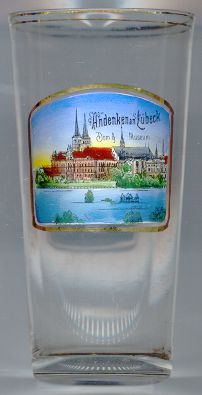 Lübeck had become the seat of a bishop in 1160. The
Lübeck had become the seat of a bishop in 1160. The  cathedral (Dom) Sankt Marien [right] was founded by Heinrich the Lion
in 1173. The huge Romanesque church (length 92 m) was completed in about 1230 and is the third-largest church in Germany, the nave
is the world's highest (40 m high) brickwork nave. In 1260 the 'paradise', a Romanesque vestibule, was added. Between 1226 and 1335 the church
was remodelled in Gothic style. The cathedral became a protestant church in 1535 (western part) and 1571 (eastern part). During the 17th and early 18h century the interior was remodelled in
Baroque style. From 1667 until 1707 the famous composer Dietrich Buxtehude was organist of St. Marien. During World War II the church
suffered heavy damages. An air raid on 29 March 1942 destroyed one fifth of the historic old town, the cathedral was almost completely destroyed.
The 'paradise' was damaged when parts of the transept collapsed in 1946. After the war it took some time until a decision about the future of the church was made.
The restoration works began in 1947. The church towers (125 m high) were the first parts to be restored. Thirty out of the original 36 bells of the historic carillon of
St. Catherine's church in Danzig (today Gdańsk, Poland) were found in Hamburg where they had
been brought during the war to be melted down. They now form a new carillon in Lübeck's cathedral. A new large organ (101 stops, almost 10,000 pipes) was
installed in 1968. The nave of the church was completed only in 1970 so that it was possible to use the building as a church again. The chancel was finished in 1977.
A glass wall separates the chancel from the nave so that the former can also be used for exhibitions and conventions. The restoration of the 'paradise' was completed
in 1982. The restoration of the triumphant crucifix of 1477 (17 m high) took six years and was finished in 1977. The astronomical clock of 1625, which had
also been destroyed, was replaced by a copy in 1967. Further art historical treasures are the Renaissance pulpit of 1568 and a baptismal font of 1455. Among the
many tombs in the church are those of the former Prince Bishops of Lübeck and Grand Dukes of Oldenburg.
cathedral (Dom) Sankt Marien [right] was founded by Heinrich the Lion
in 1173. The huge Romanesque church (length 92 m) was completed in about 1230 and is the third-largest church in Germany, the nave
is the world's highest (40 m high) brickwork nave. In 1260 the 'paradise', a Romanesque vestibule, was added. Between 1226 and 1335 the church
was remodelled in Gothic style. The cathedral became a protestant church in 1535 (western part) and 1571 (eastern part). During the 17th and early 18h century the interior was remodelled in
Baroque style. From 1667 until 1707 the famous composer Dietrich Buxtehude was organist of St. Marien. During World War II the church
suffered heavy damages. An air raid on 29 March 1942 destroyed one fifth of the historic old town, the cathedral was almost completely destroyed.
The 'paradise' was damaged when parts of the transept collapsed in 1946. After the war it took some time until a decision about the future of the church was made.
The restoration works began in 1947. The church towers (125 m high) were the first parts to be restored. Thirty out of the original 36 bells of the historic carillon of
St. Catherine's church in Danzig (today Gdańsk, Poland) were found in Hamburg where they had
been brought during the war to be melted down. They now form a new carillon in Lübeck's cathedral. A new large organ (101 stops, almost 10,000 pipes) was
installed in 1968. The nave of the church was completed only in 1970 so that it was possible to use the building as a church again. The chancel was finished in 1977.
A glass wall separates the chancel from the nave so that the former can also be used for exhibitions and conventions. The restoration of the 'paradise' was completed
in 1982. The restoration of the triumphant crucifix of 1477 (17 m high) took six years and was finished in 1977. The astronomical clock of 1625, which had
also been destroyed, was replaced by a copy in 1967. Further art historical treasures are the Renaissance pulpit of 1568 and a baptismal font of 1455. Among the
many tombs in the church are those of the former Prince Bishops of Lübeck and Grand Dukes of Oldenburg.
The picture on the glass also shows the former  Naturhistorische Museum [centre foreground].
The museum was opened in 1893 and was based on the extensive collection of the Lübeck physician and naturalist Johann Julius Walbaum (1724–1799).
The museum and its collection was completely destroyed by the bomb raid in 1942. A new museum of natural history was opened in 1963.
Naturhistorische Museum [centre foreground].
The museum was opened in 1893 and was based on the extensive collection of the Lübeck physician and naturalist Johann Julius Walbaum (1724–1799).
The museum and its collection was completely destroyed by the bomb raid in 1942. A new museum of natural history was opened in 1963.
Famous people of Lübeck:
The printer Johann BALHORN the younger worked in Lübeck between 1575 and 1604. Famous is his new edition of the Lübeck municipal laws, published in 1586. This version contained numerous discrepancies to the original of the 13th century. As a great number of other towns also conformed to this code, Balhorn's edition became the reason for many legal disputes. Although the changes were not introduced by Balhorn himself, but by two lawyers of the city council, the German word verballhornen (transmogrify) was later derived from his name.
The former Chancellor of the Federal Republic of Germany, Willy BRANDT (1913 1992; born Herbert Ernst Karl FRAHM) was born in Lübeck. In 1933 he fled to Denmark and Norway, in 1940 to Sweden. He returned to Germany in 1945 as press correspondent and regained the German citizenship in 1947 under the pseudonym that he had used as a writer. 1957–1966 he was mayor (governing burgomaster) of Berlin, 1966–1969 Foreign Minister and Vice Chancellor. From 1976 he was President of the Labor and Socialist International. Between 1969 and 1974 he headed the German government as Federal Chancellor. In 1971 he received the Nobel Peace Award.
The famous German writers Heinrich MANN (1871–1950) and Thomas MANN (1875–1955) were born in Lübeck.
Thomas Mann received the Nobel Award for Literature in 1929.
![[scale]](lineal.jpg)